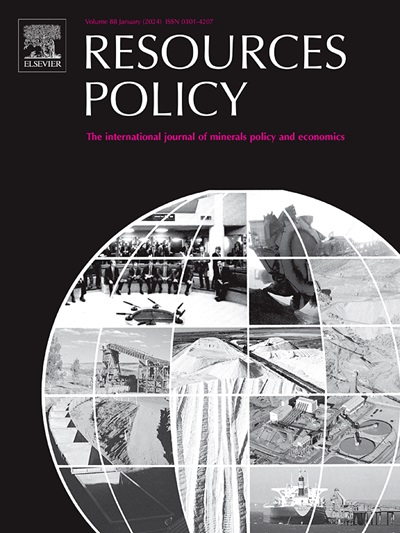Global iron ore trade network resilience assessment and shock response patterns of critical economies
IF 10.2
2区 经济学
0 ENVIRONMENTAL STUDIES
引用次数: 0
Abstract
Iron ore is one of the critical strategic resources, emphasizing the importance of maintaining the trade system stability and predicting potential risks to analyze its trade network resilience and the shock response patterns of critical economies. This paper constructs the global iron ore trade networks (GIOTNs) using the CEPII database covering 219 economies in 2000–2023. We measure network resilience, node resilience, and explore the impact of economies on network resilience using two interrupt simulation strategies. Then, we identify the critical nodes, analyzing their shock response patterns and their driving factors based on the two-way fixed effects model. We report that: (I) The number of trade relationships, clustering, and information transfer exhibit an overall growth trend, with network density at a relatively higher level, suggesting that the GIOTNs have higher network diversity and connectivity. The fluctuation range of assortativity is relatively small, and there are obvious reciprocal trade relationships in the GIOTNs, resulting in higher network stability. Consequently, the resilience of GIOTNs is constantly increasing. (II) Developed economies have higher trade diversity, Asian economies have higher product demand, Australia and Brazil have higher product supply, the Netherlands and China play important trade bridge roles, China has stronger trade transmission power. (III) The impact of economies on the network resilience of GIOTNs not only exhibits obvious hierarchical characteristics, but also shows an obvious correlation under the import trade diversity and product supply, import and export trade diversity, trade diversity and trade bridge location. (IV) Critical economies gradually form seven shock response patterns that affect the resilience of the GIOTNs, empirical analysis indicates that these shock response patterns are potentially driven by the economy’s trade diversity, trade bridge position, and iron ore production, especially in the trade bridge position.
全球铁矿石贸易网络弹性评估及关键经济体冲击响应模式
铁矿石是重要的战略资源之一,强调了维护贸易体系稳定性和预测潜在风险的重要性,以分析其贸易网络弹性和关键经济体的冲击响应模式。利用CEPII数据库构建了2000-2023年219个经济体的全球铁矿石贸易网络(GIOTNs)。我们测量网络弹性、节点弹性,并使用两种中断模拟策略探索经济对网络弹性的影响。然后,基于双向固定效应模型,识别关键节点,分析其冲击响应模式及其驱动因素。研究发现:(1)贸易关系数量、集群数量和信息传递数量总体呈增长趋势,网络密度处于较高水平,表明GIOTNs具有较高的网络多样性和连通性。分类度的波动幅度相对较小,giotn中存在明显的互惠贸易关系,网络稳定性较高。因此,giotn的弹性不断增加。(二)发达经济体贸易多样性较高,亚洲经济体产品需求较高,澳大利亚和巴西产品供给较高,荷兰和中国发挥重要的贸易桥梁作用,中国具有较强的贸易传导能力。(三)经济体对giotn网络弹性的影响不仅表现出明显的层次特征,而且在进口贸易多样性与产品供给、进出口贸易多样性、贸易多样性与贸易桥梁区位下表现出明显的相关性。(四)关键经济体逐渐形成影响GIOTNs弹性的七种冲击响应模式,实证分析表明,这些冲击响应模式可能受到经济体的贸易多样性、贸易桥梁地位和铁矿石产量的驱动,尤其是在贸易桥梁地位。
本文章由计算机程序翻译,如有差异,请以英文原文为准。
求助全文
约1分钟内获得全文
求助全文
来源期刊

Resources Policy
ENVIRONMENTAL STUDIES-
CiteScore
13.40
自引率
23.50%
发文量
602
审稿时长
69 days
期刊介绍:
Resources Policy is an international journal focused on the economics and policy aspects of mineral and fossil fuel extraction, production, and utilization. It targets individuals in academia, government, and industry. The journal seeks original research submissions analyzing public policy, economics, social science, geography, and finance in the fields of mining, non-fuel minerals, energy minerals, fossil fuels, and metals. Mineral economics topics covered include mineral market analysis, price analysis, project evaluation, mining and sustainable development, mineral resource rents, resource curse, mineral wealth and corruption, mineral taxation and regulation, strategic minerals and their supply, and the impact of mineral development on local communities and indigenous populations. The journal specifically excludes papers with agriculture, forestry, or fisheries as their primary focus.
 求助内容:
求助内容: 应助结果提醒方式:
应助结果提醒方式:


